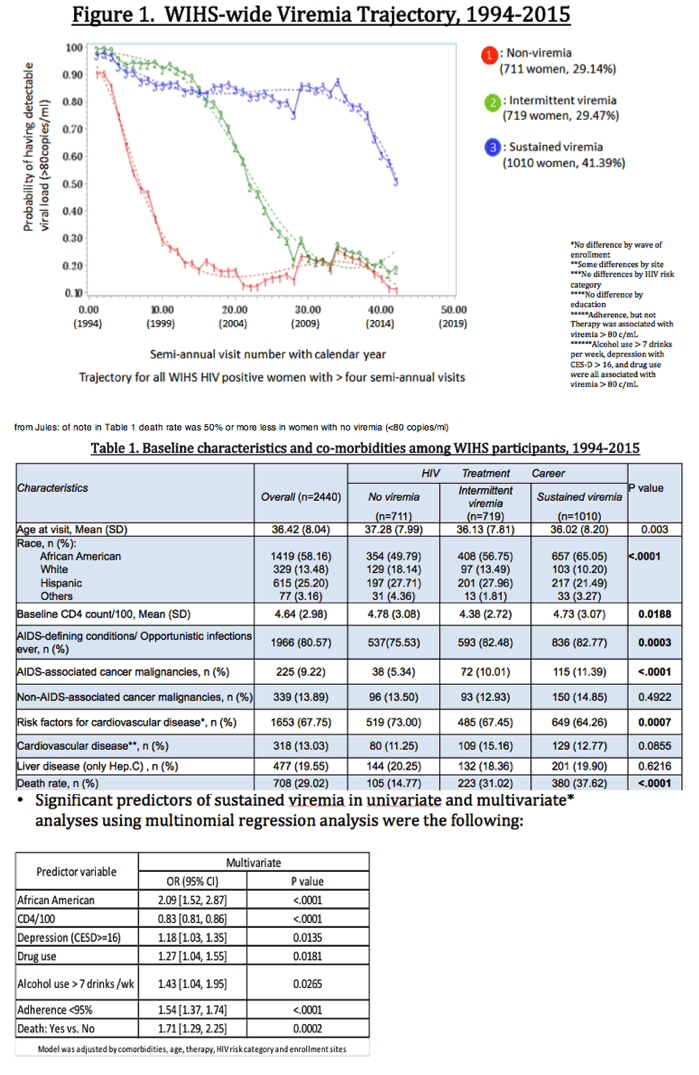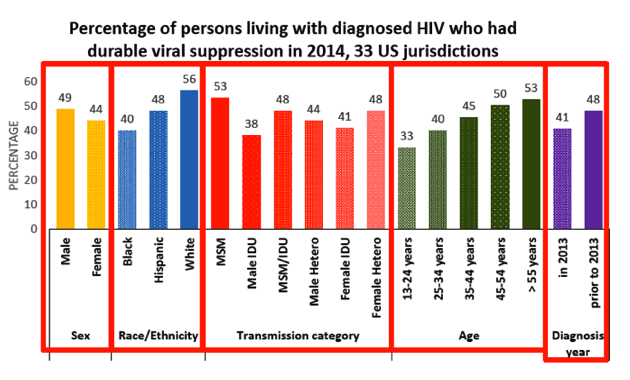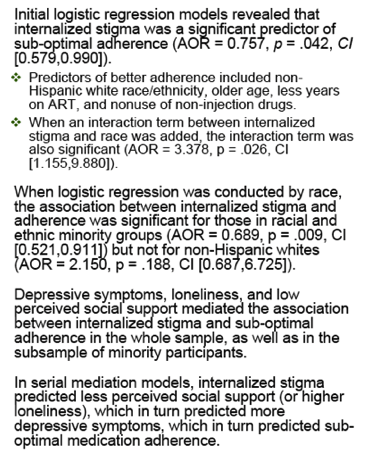| |
WIHS HIV+ Women - More falls, comorbidities, cognitive impairment, isolation/loneliness, self-stigma, detectable viral load; CDC Viral Suppression is Over Estimated in the USA
|
| |
| |
Women with HIV - CDC: Over- Estimated Viral Suppression ...WIHS Women: higher risk for - falls, comorbidities, cognitive impairment, Detectable Viral Load - Doubles the MORTALITY Rate
From Jules: below are links to a series of reports - first, is a CDC CROI 2017 presentation reporting lower rates of viral suppression in the USA and saying this is because other studies evaluate viral suppression based on one viral load test but the CDC data is based on longitudinal viral load testing. (1) several studies on WIHS women finding questionable viral load suppression & linking detectable viral load to higher rates of comorbidities rates & this to increased mortality; (2) more falls among WIHS women; (3) greater rates of cognitive impairment; (3) greater non adherence among WIHS women & linked to depression, loneliness, perceived lack of social support, isolation; (4) a series of studies at the bottom linking childhood trauma, sexual abuse to HIV and various comorbidities in HIV+
25% of HIV+ middle aged women in WIHS (36-48) experienced 2+ falls
Frailty Predicts Recurrent but Not Single Falls 10 Years Later in HIV+ and HIV- Women - (11/04/17)
------------------------------------------
CROI: Cognitive Complaints and Development of Falls among HIV-Infected and Uninfected Women - (03/06/17)...."Cognitive complaints (self-reported major problems with memory or concentration, confusion, or inability to perform routine mental tasks) by women were associated with increased odds of having a fall..,previously reported high prevalence of falls in WIHS, 18-19% had 1 or more falls in past 6 months"
--------------------------------------
"40% reported falls in the previous year/HIV+ in VA Aging
Cohort"....http://www.natap.org/2014/IDSA/IDSA_42.htm
WHO IS MANAGING AGING PATIENTS & THEIR RISK FOR FALLS ? No ONE - Jules Levin, NATAP - (02/09/17)
"median age 57....mean CD4 count 507...40% reported falls in the previous year.....32% had severe/moderate loneliness, 50% low degree of perceived social support, 49.9% low physical social support, 26% moderate/severe depression, 33% possible cognitive impairment, 26.8% anxiety, 12.5% PTSD, 11% poor/very poor/fair adherence, 30% fair/poor health, 60% income <20,000, 30% illicit drug use......"On cognitive screening, 40% had MOCA (mental/cognitive) scores < 26; 58% had findings of loneliness; 60% the lowest levels of perceived social support; 55% depression; 50% anxiety; 12% PTSD (Table 2).....On functional screening, 26% (91) reported difficulty with ≥1 ADL, 39% (136) reported they needed assistance with ≥1 IADL, and 40% reported falls in the previous year (Table 2).....slower gait speed and chair-to-standing times (p=0.002, p=0.003). They also had lower anxiety (p = 0.013) and less alcohol use (p=0.009)"
------------------------------------
Long Term Viral Suppression Uncommon, Surprisingly High Proportion of women Exhibit Intermittent viral Suppression - Psycho-Social Elements That Deter Long Term Viral Suppression in this group
CROI: LONGITUDINAL VIRAL TRAJECTORY [and Comorbidities] AMONG WOMEN IN THE WOMEN'S INTERAGENCY HIV STUDY - (02/26/17)....20% are on HAART, 39% on ART & 30.47% of women on HAART & 38% on ART are reported here to have undetectable viral load..........5% to 11% have AIDS-associated cancer malignancies which doubled if detectable viral load, 13-15% had Non-AIDS associated cancer malignancies, 64-73% have risk factors for cardiovascular disease, 11-15% have CVD, 20% with HCV, death rate 14-30% which doubled with detectable viral load / AIDS cancer malignancies associated with detectable VL
WIHS data at CROI 2017 report discouragingly low viral suppression rates that appear to be lower than commonly thought And in NYC-
- Long Term Viral Suppression Uncommon, Surprisingly High Proportion of women Exhibit Intermittent viral Suppression - Psycho-Social Elements That Deter Long Term Viral Suppression in this group
- Unexpected Increase ion Self Reported Risk Factors for CVD Among Women with Long Term Viral Suppression
CROI: Longitudinal HIV Viral Trajectories and Co-Morbidities Longitudinal in the WIHS: Viral Suppression Key to Survival - (02/16/17) - "On multivariate analysis, individuals with AIDS defining conditions and AIDS-associated cancers were more likely to have sustained viremia .....Compared to women with sustained viremia, women with viral suppression were more likely (HR 1.4, p=0.0072) to report risk factors for cardiovascular disease (hypertension, hyperlipidemia, diabetes), without concurrent increased risk of cardiovascular disease outcomes" from Jules: perhaps long term viral suppression reduces inflammation but risk factors like lipids etc may be greater on HAART.

-----------------------------------------------
CDC - CROI: Viral Load Dynamics Among Persons with Diagnosed HIV: United States, 2014 - (02/16/17) CDC - "the continuum of care outcome measure, which relies on single viral load measures, overestimates viral suppression by 20%....longitudinal measures better inform viral burden & treatment & care efforts....about half with diagnosed HIV in the US in 2014 had durable viral suppression"

----------------------------------------
WIHS
Depression and Social Isolation Mediate Effect of HIV Stigma on Women's ART Adherence - (02/26/16)
"findings suggest that potential predictors of adherence may operate differently by race.....contribute to our understanding of different rates of adherence and health outcomes by race among women living with HIV.....also suggest that interconnected psychosocial mechanisms affect ART adherence.....internalized stigma was a significant predictor of sub-optimal adherence....Predictors of better adherence included non-Hispanic white race/ethnicity, older age, less years on ART, and nonuse of non-injection drugs.....the association between internalized stigma and adherence was significant for those in racial and ethnic minority groups.....Depressive symptoms, loneliness, and low perceived social support mediated the association between internalized stigma and sub-optimal adherence in the whole sample, as well as in the subsample of minority participants.....internalized stigma predicted less perceived social support (or higher loneliness), which in turn predicted more depressive symptoms, which in turn predicted suboptimal medication adherence."

--------------------------------------------
9-YEAR TRENDS IN NON-LIPID CARDIOVASCULAR DISEASE PREVENTION STRATEGIES IN HIV+ WOMEN in WIHS-women have poor control of diabetes & hypertension
"Use of hypertensive and diabetes medications increased among both HIV+ and HIV- women but coincided with only small or no improvements in risk factor control" "HIV+ women more effectively manage hypertension and diabetes than HIV- women from the same risk population - However, more than 40% of hypertensive and 25% of diabetic HIV+ women still did not achieve target control levels"
--------------------------------------------
Love with HIV: a latent class analysis of intimate relationships among women living with HIV enrolled in Canada's largest multisite community-based research study...."Nearly half of Canadian WLWH were not in relationships" - (07/25/16) 20% report long-term happy relationships.....Take a look at Table 2 where you will see depression & stigma are preset in around 50% of all women; viral load undetectable in about 80%. How many people tell me - oh HIV is under control today, its not a problem, tell this to HIV men & women who are unable to form relationships & suffer with the stigma & depression associated with having HIV !....27% Depressed / 20% Detectable Viral Load / 40% High Stigma / 16% Illicit Drug Use
47% no relationship
9% relationship without love
short-term casual 16%
long-term unhappy 7%
long term happy 22%
----------------------------------------
Childhood Trauma and Health Outcomes in HIV-Infected Patients: An Exploration of Causal Pathways- (03/23/12)
"greater lifetime trauma exposure was associated with all outcomes considered (Table 3). Each additional type of lifetime trauma was associated with 18% increased odds of unprotected sex, 13% (3% to 24%) increased odds of ARV nonadherence, 12% (4% to 21%) increased odds of hospitalization, 14% (6% to 22%) increased odds of ED use, 13% (5% to 22%) increased odds of more than 4 days in bed, a 12% (0% to 24%) increased hazard of HIV disease progression, and a 0.8-unit (0.4-1.2) lower SF36 physical health score."
The Pervasive Effects of Childhood Sexual Abuse: Challenges for Improving HIV Prevention and Treatment Interventions EDITOIRAL-- (03/23/12)
Associations of Sexual Identity or Same-Sex Behaviors With History of Childhood Sexual Abuse and HIV/STI Risk in the United States-- (03/23/12)
Study of the Day: 1 in 4 Adults With HIV Were Sexually Abused as Kids-- (03/23/12)
Depression Tied to Worse Cognitive Function in MACS Men With or Without HIV.....http://www.natap.org/2015/AGE/AGE_13.htm
Does Social Isolation Predict Hospitalization and Mortality Among HIV+ and Uninfected Older Veterans? [yes] - (12/02/17)
|
|
| |
| |
|
|
|